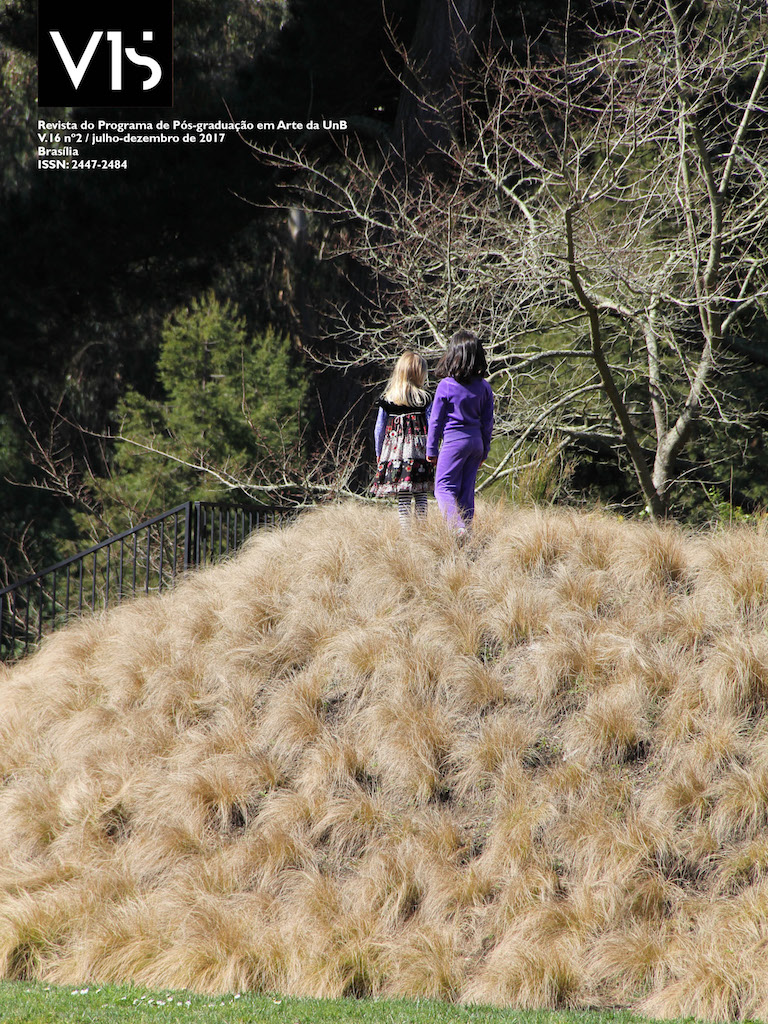Encontrando o meu caminho para a a/r/tografia
DOI:
https://doi.org/10.26512/vis.v16i2.20649Palavras-chave:
A/r/tografia. Investigação baseada em artes. Pesquisa interdisciplinar.Resumo
O objetivo deste artigo é compreender melhor a filosofia, a teoria e os princípios da a/r/tografia e como eles podem ser aplicados a indivíduos u a uma comunidade de pesquisadores
de arte trabalhando nas ciências sociais e humanidades. Em 2004, Rita Irwin cunhou o termo a/r/tografia e desenvolveu uma prática de pesquisa baseada nas artes baseada nos fundamentos filosóficos dos três tipos de pensamento de Aristóteles: saber (teoria), fazer (práxis) e poética (poesis) “(Irwin, 2004: 27). Ela amplia esses entendimentos para a pesquisa educacional (ver Dewey, 1934) e expande a pesquisa baseada em artes (ver Eisner, 1979, 1991, Barone & Eisner, 1997) para considerar a metodologia da a/r/tografia para artistas, pesquisadores e professores como uma pesquisa viva. Irwin sugere que os a/r/tógrafos trabalhando em um coletivo cria a oportunidade de reexaminar, reconfigurar e reescrever histórias, que antes eram incompreendidas ou invisíveis. As ideias resultantes proporcionam perspectivas multifacetadas, oferecendo uma rica compreensão de experiências estéticas, performatividade e expressões poéticas ligadas à erudição intelectual. As implicações deste trabalho acadêmico é que os pesquisadores baseados em arte irão adquirir uma compreensão mais profunda do desenvolvimento histórico da biografia e seu potencial para ampliar a pesquisa em ciências sociais e humanidades através de práticas interdisciplinares, reunindo comunidades de pesquisadores de diversas disciplinas.
Downloads
Referências
BAKER, Kimberly, “Is Suburbia Sustainable?” (Unpublished article, The University of British Columbia, p. 1-8, 2011.
BARONE, Tom; EISNER, Elliot. “Arts-based educational research.” In JAEGER, Ricard. Complementary methods for research in education. American Educational Research Association, 2nd Edition, p. 75-116, 1997.
REPORT TO MAYOR AND COUNCIL. Township of Langley: Community Development Division. Subject: Streamside Protection and Enhancement Bylaw No. 4400. March, 6, 2006.
CULLEN, Jim. The American dream: A short history of an idea that shaped a nation. USA: Oxford University Press, 2004.
DEWEY, John. Art as experience. Penguin, 2005.
EISNER, E. W. The promise and perils of alternative forms of data representation. Educational researcher, v. 26, n. 6, p.4-10, 1997
_____. “Recent developments in educational research affecting art education.” Art Education v. 32, n. 4, p.12-15, 1979.
_____. “What the arts taught me about education.” Art Education v. 44, n. 5, p. 10-19, 1991.
HARRIS, Richard; LARKHAM, Peter, Eds. Changing suburbs: foundation, form and function. London: Routledge, 2003.
IRWIN, Rita L. “Becoming A/r/tography.” Studies in Art Education V 54, no. 3, p. 198-215, 2013.
IRWIN, Rita L.; COSSON Alex de, Eds. A/r/tography: Rendering self through arts-based living inquiry. Vancouver, Canada: Pacific Educational Press, 2004.
IRWIN, Rita, SPRINGGAY, Stephanie A/r/tography as Practice-based Research. In IRWIN, R.; SPRINGGAY, S.; LEGGO, C., GOUZOUASIS. Being with A/r/tography, Rotterdam: Sense Publishers, 2008.
LEOPOLD, Aldo. Round River. New York: Oxford University Press, Inc.p..145-146, 1993.
MCDOWELL, Bill. Historical Research: A Guide for Writers of Dissertations, Theses, Articles and Books. London: Routledge, 2015.
NECHYBA, Thomas J., WALSH, Randall P. “Urban sprawl.” The Journal of Economic Perspectives v. 18, n.4, p. 177-200, 2004.
O’DONOGHUE, Dónal. “Are we asking the wrong questions in arts-based research?” Studies in Art Education v. 50, n. 4, p. 352-368, 2009.
______. “That Stayed With Me Until I Was An Adult: Making Visible The Experiences of men Who Teach”. In SPRINGGAY, S., IRWIN, R., LEGGO, C., GOUZOUASIS, P. Being with A/r/tography. S, Rotterdam: Sense Publications, 2008.
PEARSE, Harold. “Praxis in perspective.” In IRWIN, Rita L.; COSSON Alex de, Eds. A/r/tography: Rendering self through arts-based living inquiry. Pacific Vancouver, Canada: Pacific Educational Press, 2004.
“Smart Growth BC.” Accessed February 2006, http:// www.smartgrowth.bc.ca
SPRINGGAY, Stephanie; IRWIN, Rita, LEGGO Carl. Eds. Being with A/r/tography. Rotterdam: Sense Publications, 2008.
WILSON, Sylvia. “Fragments: Life writing in image and text.” In IRWIN, Rita L.; COSSON Alex de. Eds. A/r/tography: Rendering self through arts-based living inquiry. Vancouver, Canada: Pacific Educational Press, 2004.




